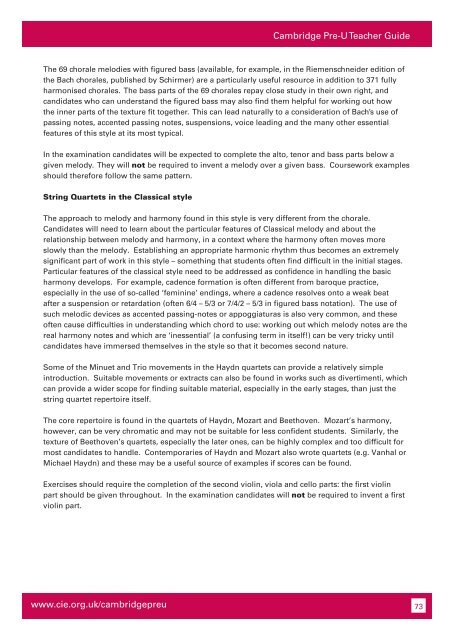Teacher's Guide Cambridge Pre-U MUSIC Available for teaching ...
Teacher's Guide Cambridge Pre-U MUSIC Available for teaching ...
Teacher's Guide Cambridge Pre-U MUSIC Available for teaching ...
Create successful ePaper yourself
Turn your PDF publications into a flip-book with our unique Google optimized e-Paper software.
<strong>Cambridge</strong> <strong>Pre</strong>-U Teacher <strong>Guide</strong><br />
The 69 chorale melodies with figured bass (available, <strong>for</strong> example, in the Riemenschneider edition of<br />
the Bach chorales, published by Schirmer) are a particularly useful resource in addition to 371 fully<br />
harmonised chorales. The bass parts of the 69 chorales repay close study in their own right, and<br />
candidates who can understand the figured bass may also find them helpful <strong>for</strong> working out how<br />
the inner parts of the texture fit together. This can lead naturally to a consideration of Bach’s use of<br />
passing notes, accented passing notes, suspensions, voice leading and the many other essential<br />
features of this style at its most typical.<br />
In the examination candidates will be expected to complete the alto, tenor and bass parts below a<br />
given melody. They will not be required to invent a melody over a given bass. Coursework examples<br />
should there<strong>for</strong>e follow the same pattern.<br />
String Quartets in the Classical style<br />
The approach to melody and harmony found in this style is very different from the chorale.<br />
Candidates will need to learn about the particular features of Classical melody and about the<br />
relationship between melody and harmony, in a context where the harmony often moves more<br />
slowly than the melody. Establishing an appropriate harmonic rhythm thus becomes an extremely<br />
significant part of work in this style – something that students often find difficult in the initial stages.<br />
Particular features of the classical style need to be addressed as confidence in handling the basic<br />
harmony develops. For example, cadence <strong>for</strong>mation is often different from baroque practice,<br />
especially in the use of so-called ‘feminine’ endings, where a cadence resolves onto a weak beat<br />
after a suspension or retardation (often 6/4 – 5/3 or 7/4/2 – 5/3 in figured bass notation). The use of<br />
such melodic devices as accented passing-notes or appoggiaturas is also very common, and these<br />
often cause difficulties in understanding which chord to use: working out which melody notes are the<br />
real harmony notes and which are ‘inessential’ (a confusing term in itself!) can be very tricky until<br />
candidates have immersed themselves in the style so that it becomes second nature.<br />
Some of the Minuet and Trio movements in the Haydn quartets can provide a relatively simple<br />
introduction. Suitable movements or extracts can also be found in works such as divertimenti, which<br />
can provide a wider scope <strong>for</strong> finding suitable material, especially in the early stages, than just the<br />
string quartet repertoire itself.<br />
The core repertoire is found in the quartets of Haydn, Mozart and Beethoven. Mozart’s harmony,<br />
however, can be very chromatic and may not be suitable <strong>for</strong> less confident students. Similarly, the<br />
texture of Beethoven’s quartets, especially the later ones, can be highly complex and too difficult <strong>for</strong><br />
most candidates to handle. Contemporaries of Haydn and Mozart also wrote quartets (e.g. Vanhal or<br />
Michael Haydn) and these may be a useful source of examples if scores can be found.<br />
Exercises should require the completion of the second violin, viola and cello parts: the first violin<br />
part should be given throughout. In the examination candidates will not be required to invent a first<br />
violin part.<br />
www.cie.org.uk/cambridgepreu 73
















